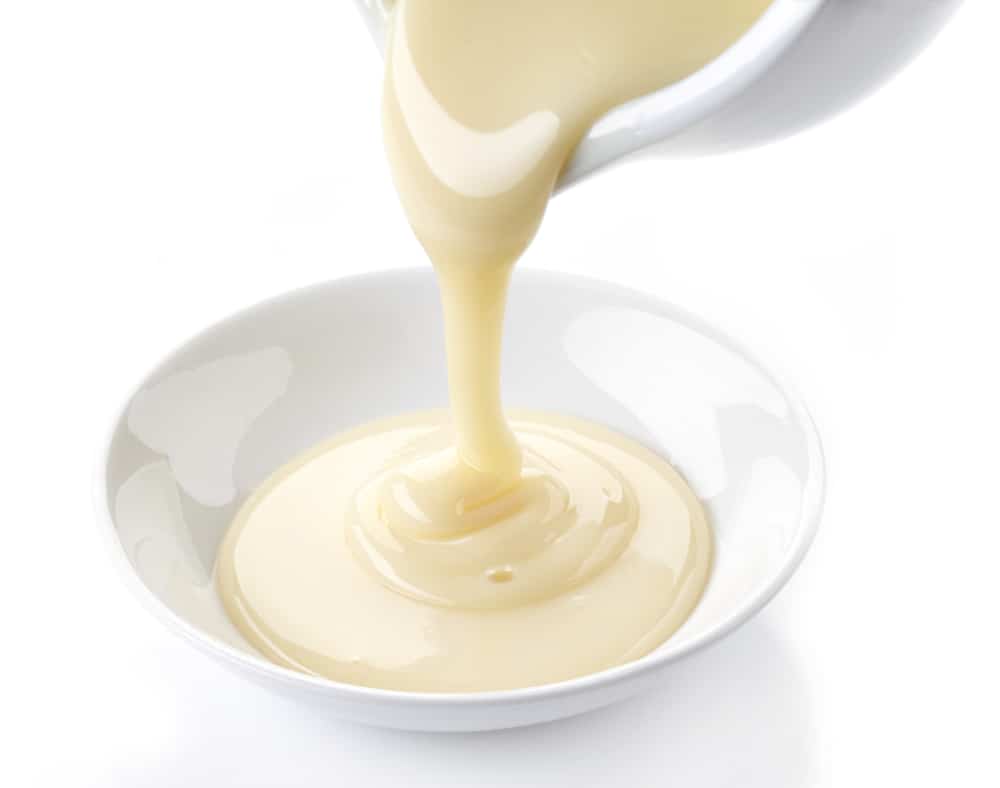If you are reading this, you might struggle to distinguish between evaporated milk and condensed milk. Both types of milk have similar names and look. They are also on store shelves. However, there is a crucial difference between both types of milk. The difference is simply the amount of sugar involved. Evaporated milk doesn’t have any added sugar, while condensed milk does.
This article aims to provide you with an overview of the crucial differences between condensed milk and evaporated milk. You will also discover the appropriate use cases for both dairy products.

What is Evaporated Milk?
Evaporated milk is a condensed type of milk delivered in cans. It is put in cans to be shelf-stable, providing a long shelf life. It was created in the 1890s after dairy product manufacturers introduced condensed products. Before its availability in cans, people made evaporated milk at home.
People simply heated the milk at a low temperature to get rid of some of the water content by evaporation. It is this process that gives the product its name. Once half of the water content evaporates, the milk is homogenized and sterilized.
You end up with a thicker, creamier milk with little water content. Evaporated milk was an alternative to fresh diluted milk with a longer shelf life. The reason evaporated milk was created was that refrigerators at the time were a luxury. So, families needed to find a way to preserve milk and the nutritional benefits for their children.
The benefits of evaporated milk
The nutritional composition of evaporated milk is regulated by the Code of Federal regulations in the US, while the Codex Alimentarius regulates it internationally. According to the CFR, evaporated milk should have the following, according to weight:
- 23% milk solids
- 6.55 milk solids, not fat MSNF
- 6.5% milkfat
Nevertheless, the regulation allows evaporated milk to be made from whole, fat-free, and reduced-fat dairy. Drinking evaporated milk is beneficial for those who want to increase their mineral intake and those trying to gain weight. Being underweight can be a risk factor for dementia, infection, and death. Nevertheless, it is imperative to do it healthily when trying to gain weight. This healthy method of weight gain can help you avoid health issues typically associated with bad eating habits.
Evaporated milk helps you gain weight due to its lack of added sugar and high concentration of nutrients. Excessive sugar consumption is linked with type 2 diabetes and heart disease. Apart from drinking evaporated milk, you can use it to prepare several dishes such as oatmeal, casseroles, soups, and mashed potatoes.
Furthermore, evaporated milk is fortified with Vitamin A and Vitamin D in various countries. It is also high in natural minerals such as phosphorus and calcium, two elements essential for bone health.
What Is Condensed Milk?

Condensed milk is a sweetened milk concentrate. The process begins with boiling regular milk at low pressure, the same process used to make evaporated milk. Once the milk’s water content reduces, sugar is added to the solution to raise its sugar content to 55%. This process results in a dairy product with a long shelf life.
Condensed milk was created in the United States in 1861 before evaporated milk. The resulting sweet milk is excellent for desserts and baked goods. It is a crucial ingredient in lemon meringue, custard, and fudge, to name a few dishes. One thing to note is that condensed milk is also known as sweetened condensed milk, as both names are synonymous. Condensed milk can contain between 40 to 55% sugar, depending on the brand. It has a caramel color and is thick, rich, and super sweet.
You will never find unsweetened condensed milk since that would make it evaporated milk.
The benefits of condensed milk
The benefits of condensed milk is that:
- It offers a great source of protein
- Like evaporated milk contains a plethora of minerals and vitamins
- It is an excellent source of calcium
Differences Between Evaporated Milk and Condensed Milk
Both kinds of milk are thick, dense dairy with a large percentage of their water content taken away. Nevertheless, that is where the similarities end. There are a couple of noticeable differences between evaporated milk and condensed milk.
Texture
When used in baked items, evaporated milk provides an airier and thinner texture, while condensed milk provides pastries with a thick creaminess.
Color
As a result of the accumulation of lactose and protein during cooking, evaporated milk has a tan hue. Conversely, condensed milk has a much lighter hue due to its significantly higher sugar content.
Flavor
Unlike evaporated milk, condensed milk doesn’t require sterilization because of its high sugar content. Since no additional heat is necessary, it lacks the caramelized taste that evaporated milk has.
Sweetness
Condensed milk has a lot more sugar content than evaporated milk, making it a lot sweeter. Dairy manufacturers initially added sugar to serve as a food preservative. Evaporated milk, however, doesn’t come with any added sweeteners.
Considering that fresh milk has about 5% of naturally occurring sugars found in lactose, the sugar content is about 10% once the milk undergoes evaporation. On average, condensed sugar has about 55% sugar content.
When to Use Evaporated Milk or Condensed Milk
Both types of milk can be great in the kitchen as you can use them in various recipes.
Evaporated milk
Evaporated milk is great at providing a silky texture to savory recipes. You can use it in the following dishes:
Homemade bread
Evaporated milk is excellent for handmade white bread as it gives it a richer aroma. The proteins in the milk also provide bread structure after baking. This results in a dense, hearty loaf.
Nacho queso dip

Evaporated milk can be combined and melted with grated cheese. Both ingredients create a smooth cheese sauce that pairs with tortilla chips.
Condensed ingredient
Condensed milk is typically used in creating desserts such as key lime pie, mocha latte fudge, and turtle bars. It is also the single ingredient used to create Dulce de Leche. Dulce de Leche is simply caramelized condensed milk. You can use condensed milk as the drizzle on a seven-layer magic bar.
Condensed milk is a popular ingredient with bakers that there are dairy-free alternatives such as condensed coconut milk. You can make the following with condensed milk:
Dulce de leche
Condensed milk should be left to simmer for a couple of hours. After this, you can spread it on your cookies or toast. Its rich brown color adds a bit of sweetness to any dish.
Mocha fudge
Typically, classic fudge requires melted sugar; however, you can swap out sugar for condensed milk to add more flavor to your food.
Comparison
To help you discern which milk is best for which situations, here are a few facts about both
Evaporated milk
- Flavor: caramelized
- Sweetness: 10%
- Color: tan
- Ingredients: 60% of water content evaporated
- Texture: light and airy
- Uses: savory dishes
Condensed milk
- Flavor: sugary
- Sweetness: 55%
- Color: lighter
- Ingredients: added sugar and 60% of water content evaporated
- Texture: dense and creamy
- Uses: dessert and sweet dishes
Can You Use Evaporated And Condensed Milk Interchangeably?
Both milk products are shelf-stable, and while they do share some similarities, it is not advisable to substitute one for another in a recipe. For instance, if you use condensed milk where the recipe calls for evaporated milk, you end up with a sweeter than necessary dish. It could also ruin the dish’s taste, especially if it is a savory dish like Mac n Cheese.
Furthermore, if you swap out condensed milk for evaporated milk, you end up with a bland dish that lacks the flavor condensed milk provides. The inclusion of sugar in making condensed milk provides it with a caramelized taste. You cannot achieve the same taste by simply blending sugar and evaporated milk. It is always best to have both types of milk in your pantry.
Nevertheless, there are times when the recipe requires an ingredient you don’t have. Here are a few alternatives you can use to help you with your cooking time.
To create an alternative to condensed milk, you can boil some evaporated milk with sugar over medium to high heat. You then lower the temperature, letting the milk simmer. Once cool, you can serve it. Alternatively, you can use coconut cream with a 1:1 ratio. You should note that you are unlikely to get close to the flavor that condensed milk provides with all these alternatives.
To create an alternative to evaporated milk, you can simply mix condensed milk with a bit of salt and then heat the mixture for about 30 minutes over medium heat.
Conclusion

A simple answer to the title question would be no. While both types of milk share a similar manufacturing process, condensed milk has the extra step of added sugar, which causes its appearance and taste to differ.
Simply switching one type of milk out for the other isn’t recommended. The results can be disappointing.
